[ad_1]
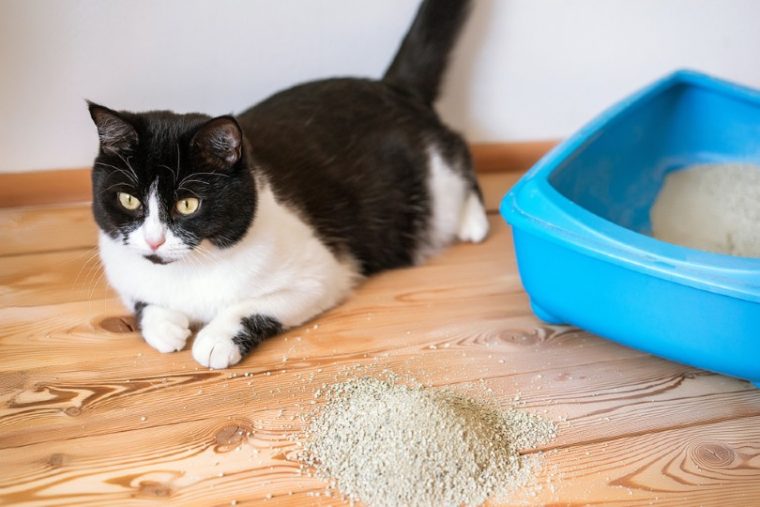
When cats age, their bodies begin to change. Many slow down, sleep more often, and play less over time. Some lose weight, and others begin suffering from mobility problems. Many older cats have trouble using the litter box, which indicates that your cat isn’t feeling so great. It can signify several conditions, including osteoarthritis and kidney disease.
It’s a good idea to have your cat checked out by a veterinarian sooner rather than later if your buddy’s bathroom or eating habits suddenly change. Read on to learn more about eight possible reasons your cat may be using the bathroom outside their litter box.

The 8 Possible Reasons Your Cat Isn’t Using Their Litter Box
1. Feline Lower Urinary Tract Disease
Cats suffering from feline urinary tract disease (FLUTD) often urinate outside of the litter box. Many only pass small amounts of urine that are often clouded or bloody. Bacteria cause classic urinary tract infections (UTIs), which require antibiotics to clear up. Some cats also suffer from urinary crystals or bladder stones, which can irritate feline urinary tracts, increasing inflammation and making it easier for cats to end up with bacterial infections. Cats with FLUTD often benefit from increased water intake to help regulate their urinary pH.
Dietary formulations designed to support feline urinary tract health often help reduce the formation of urinary crystals and bladder stones. Neutered male cats are at heightened risk of developing urinary tract conditions. Contact your veterinarian if your cat struggles to pass urine for more than a few hours, as feline urinary obstructions are considered a veterinary emergency and can be fatal if not promptly treated. Both bladder stones and bacterial urinary tract infections are more common in older cats.
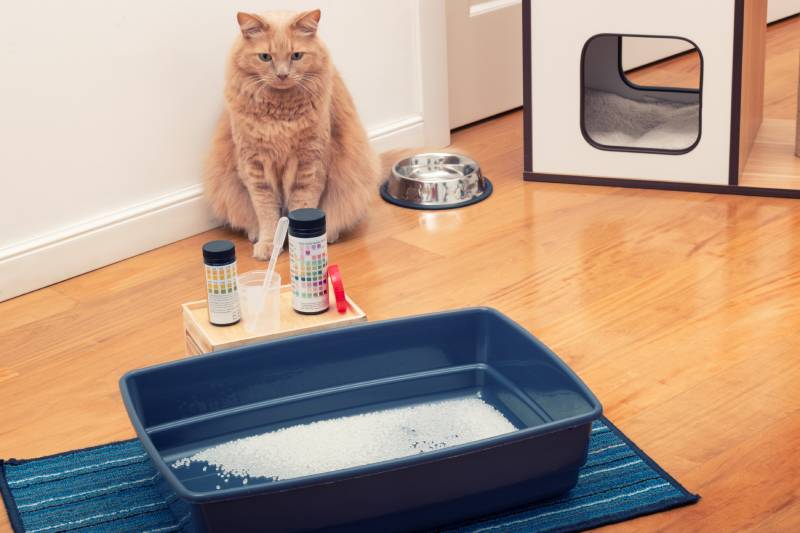
2. Hyperthyroidism
Hyperthyroidism occurs relatively frequently in older cats. Cats with the condition often lose weight, vomit, and vocalize excessively. Others drink more and pee far more frequently than usual, sometimes resulting in missed litter box incidents. Veterinarians typically rely on blood tests for diagnosis. The condition can often be managed with medication.
3. Osteoarthritis (OA)
Osteoarthritis is a chronic condition in which cats’ joints become painfully inflamed and degenerate over time. Although it’s not caused by old age, around 90% of cats older than 12 display signs of the disease. Overweight cats are at higher risk for developing the condition. Signs often include mobility problems and gait changes. While there’s no cure for feline arthritis, there are several steps you can take to help manage the condition and reduce your cat’s discomfort.
Dropping a few pounds often helps increase arthritic cats’ mobility, and regular low-impact exercise provides effective pain relief for many animals. There are also prescription medications that may be useful for reducing inflammation and addressing pain. Some veterinarians also recommend that arthritic cats take supplements such as glucosamine, chondroitin, and omega-3 fatty acids to support joint health.

4. Cognitive Decline
Cats sometimes stop using the litter box when suffering from cognitive decline or feline dementia. The condition is most often seen in cats over the age of 10 and worsens over time. Around 50% of cats over 15 have trouble with cognitive functions. Signs of the condition include wandering, excessive vocalization, and lack of appetite. Some cats struggling with feline dementia have difficulty grooming themselves and seem to forget long-standing routines.
A diagnosis involves a physical exam and a review of your pet’s behavior. Blood tests and other imaging studies are sometimes used to rule out other possible causes. Treatment includes medication, dietary changes, and behavioral therapy, such as increased exercise and playtime.
5. Chronic Kidney Disease (CKD)
Cats with CKD often drink more than usual and need to go to the bathroom frequently. They don’t have much energy and generally don’t feel well. Many try but can’t make it to the bathroom fast enough.
Cats with CKD often pee a lot, which can quickly result in built-up urine and a litter box too smelly for feline comfort. There’s no cure for CKD; it’s a progressive condition that often gets worse over time. Kidney disease treatments can include special diets, medications, and fluid injections. Although the chronic illness is not curable, the side effects can be managed to make life more comfortable for the cat.
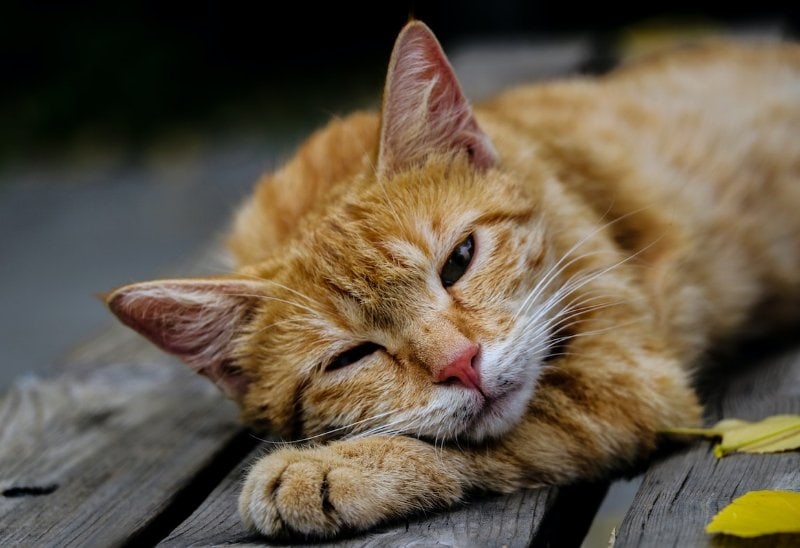
6. Muscle Atrophy
Older cats often lose muscle tone and strength as they age, which can make it difficult for them to walk and jump. Muscle loss and atrophy are commonly seen in cats older than 11. Although the precise mechanism for the phenomenon is unclear, some suspect it’s linked to changes in feline metabolism and gut function that result in cats absorbing fewer nutrients as they age. It can also be caused by diseases such as cancer and diabetes. Older cats sometimes lose weight and muscle tone because they aren’t eating enough.
Cats with mobility issues often avoid eating if getting to their food bowl causes pain or requires too much energy. Dental disease and the side effects of medication can also put some cats off their food. Cats with weak muscles often struggle to enter tall litter boxes, and some also have trouble going up and down stairs to reach the litter box, leading to accidents.
7. Blindness
Older cats often stop using the litter box due to vision problems. Cats having trouble finding their way around the house because of vision loss sometimes can’t reliably find the litter box or situate themselves properly when peeing. Several conditions, including high blood pressure, cataracts, conjunctivitis, and glaucoma, can cause vision difficulties.
Signs of feline blindness and vision trouble include a reluctance to jump onto furniture and general clumsiness. Blind cats often live long and healthy lives, particularly when any underlying conditions are promptly treated. Most blind cats adapt well since cats rely heavily on smell and hearing to navigate the world. Putting litter boxes in readily accessible places and minimizing home layout changes often make it easier for blind cats to get around and stay active in household activities.

8. Stress and Anxiety
Older cats are often sensitive to environmental changes. Many don’t react well to the introduction of new pets or the arrival of babies. Repetitive loud noises associated with home renovations can also cause feline anxiety. Signs of stress in cats include changes in eating habits, urinating outside of the litter box, and a lack of interest in interacting.
Providing cats with cat trees and napping spaces often reduces feline stress. Increased exercise usually helps as well. Consider creating a feline-friendly space with cat trees, toys, and a litter box, so your companion can retreat when overwhelmed. Introducing new pets slowly often reduces stress for everyone involved and can increase the likelihood of your companions getting along in the long run. Cats often do fine around new babies when exposed to the infant sounds and aromas in advance.

Is There Anything I Can Do To Help My Cat?
The first step is to have your cat checked out by a veterinarian. Cats that suddenly stop using the litter box often have an underlying condition causing the behavior. Sudden behavioral changes usually indicate illnesses in cats, particularly changes to eating and bathroom habits.
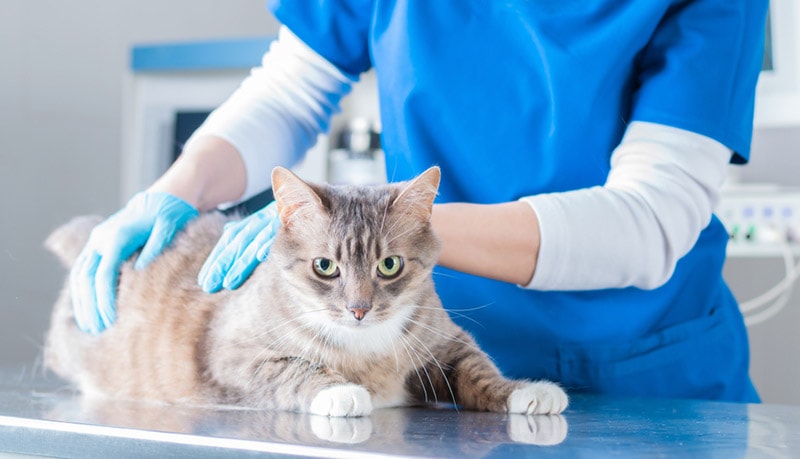
Litter Box Location
But there are several things you do to make it easier for older cats to make it to the bathroom, which can significantly improve your cat’s quality of life and reduce accidents. Put your cat’s litter in an easy-to-reach location, where they don’t have to go up or down stairs from their favorite hangout to pee. Consider purchasing extra litter boxes and placing them around your home to make it easy for your pet to get to the bathroom without going too far.
Larger boxes give cats more room to maneuver and make it easier for them to hit the mark when squatting hurts! If your litter box has tall sides, you can replace it with a box with shorter walls to make entering easier.
Frequent Litter Box Cleaning
Cats are extra sensitive to smells, so consider changing your cat’s litter box more frequently to ensure your buddy has a pleasant environment to relieve itself. Cats with conditions such as kidney disease often urinate more frequently, and pets with mobility issues sometimes have trouble digging and finding places to relieve themselves. A squeaky clean litter box provides an inviting place for your pet to go to the bathroom, which is incredibly important when your feline isn’t feeling well.
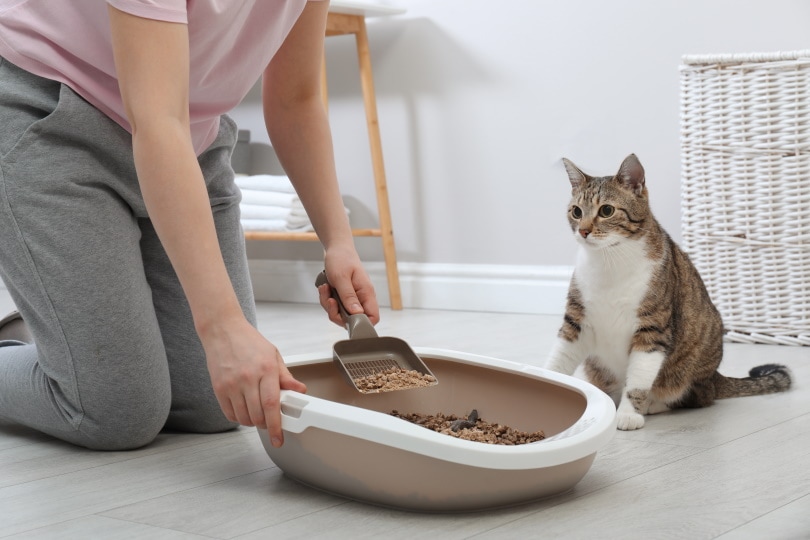

Conclusion
Peeing outside of the litter box often indicates an illness or distress. However, it can be caused by several conditions, so it’s essential to contact your veterinarian for an accurate diagnosis, as most feline health conditions benefit from prompt treatment. Consider moving your pet’s litter box to a place that’s easily accessible and doesn’t require your pet to navigate stairs to answer nature’s call. Cleaning the box frequently, replacing tall models with shorter ones, and maintaining regular veterinary appointments can help your aging feline use the litter box.
Featured Image Credit: Tanya Plotnikova, Shutterstock
